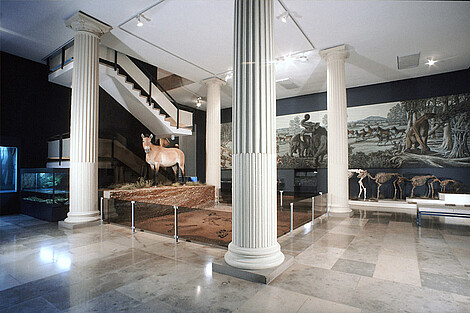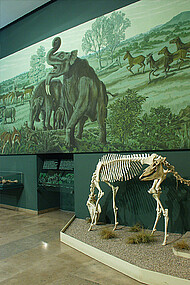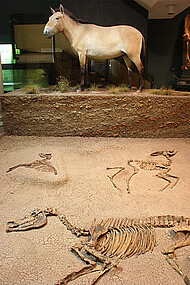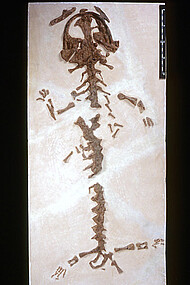There are two significant sites in the southern Baden region where palaeontologists discovered mammals from the Neogene period. We have dedicated a separate exhibition space to these two areas: Höwenegg in the volcanic region of the Hegau and Öhningen near Lake Constance.
Our exhibition presents fossils of the animals and plants which lived near the extinct volcano Höwenegg some 11 million years ago. The fossils were excavated by staff members of the Natural History Museum Karlsruhe in the 1950s. In addition to the sabre-toothed cat (Homotherium) and the unusual "gorilla horse" (Chalicotherium), you can also see the the impressive size and shape of the hoe tusker Deinotherium, an extinct member of the horse family. Höwenegg became famous due to the Hippotherium found there, a three-toed horse which is thought to have roamed the steppes and savannas in large herds like the modern-day zebra. One of the many Hippotherium skeletons found there is on display at the Museum in a reconstruction of the excavation site.
The fossil site at Öhningen near Lake Constance was equally rich in flora and fauna. Around 13 million years ago, the lake in Öhningen was teeming with fish, amphibians and freshwater turtles, many of which have been preserved in outstanding condition. One historical event was the 1726 description of the giant salamander Andrias scheuchzeri, which Jakob Scheuchzer, a Zurich physician, interpreted as the skeleton of a "poor sinner" who drowned in the Great Flood of the Old Testament. Giant salamanders of the same genus still exist in two species found in China and Japan. They grow up to 180 centimetres in length and weigh over 12 kilos. The exhibition features the museum's "mascot", a living Chinese giant salamander (Andrias davidianus).










